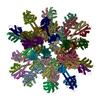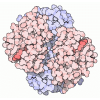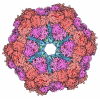+ データを開く
データを開く
- 基本情報
基本情報
| 登録情報 | データベース: PDB / ID: 7b0u | ||||||
|---|---|---|---|---|---|---|---|
| タイトル | Stressosome complex from Listeria innocua | ||||||
 要素 要素 |
| ||||||
 キーワード キーワード | SIGNALING PROTEIN / Stressosome / stress sensing / general stress response / phosphorylation cascade | ||||||
| 機能・相同性 |  機能・相同性情報 機能・相同性情報 | ||||||
| 生物種 | Listeria innocua serovar 6a | ||||||
| 手法 | 電子顕微鏡法 / 単粒子再構成法 / クライオ電子顕微鏡法 / 解像度: 3.86 Å | ||||||
 データ登録者 データ登録者 | Miksys, A. / Fu, L. / Madej, M.G. / Ziegler, C. | ||||||
| 資金援助 |  ドイツ, 1件 ドイツ, 1件
| ||||||
 引用 引用 |  ジャーナル: Commun Biol / 年: 2022 ジャーナル: Commun Biol / 年: 2022タイトル: Molecular insights into intra-complex signal transmission during stressosome activation. 著者: Algirdas Miksys / Lifei Fu / M Gregor Madej / Duarte N Guerreiro / Susann Kaltwasser / Maria Conway / Sema Ejder / Astrid Bruckmann / Jon Marles-Wright / Richard J Lewis / Conor O'Byrne / Jan ...著者: Algirdas Miksys / Lifei Fu / M Gregor Madej / Duarte N Guerreiro / Susann Kaltwasser / Maria Conway / Sema Ejder / Astrid Bruckmann / Jon Marles-Wright / Richard J Lewis / Conor O'Byrne / Jan Pané-Farré / Christine Ziegler /    要旨: The stressosome is a pseudo-icosahedral megadalton bacterial stress-sensing protein complex consisting of several copies of two STAS-domain proteins, RsbR and RsbS, and the kinase RsbT. Upon ...The stressosome is a pseudo-icosahedral megadalton bacterial stress-sensing protein complex consisting of several copies of two STAS-domain proteins, RsbR and RsbS, and the kinase RsbT. Upon perception of environmental stress multiple copies of RsbT are released from the surface of the stressosome. Free RsbT activates downstream proteins to elicit a global cellular response, such as the activation of the general stress response in Gram-positive bacteria. The molecular events triggering RsbT release from the stressosome surface remain poorly understood. Here we present the map of Listeria innocua RsbR1/RsbS complex at resolutions of 3.45 Å for the STAS domain core in icosahedral symmetry and of 3.87 Å for the STAS domain and N-terminal sensors in D2 symmetry, respectively. The structure reveals a conformational change in the STAS domain linked to phosphorylation in RsbR. Docking studies indicate that allosteric RsbT binding to the conformationally flexible N-terminal sensor domain of RsbR affects the affinity of RsbS towards RsbT. Our results bring to focus the molecular events within the stressosome complex and further our understanding of this ubiquitous signaling hub. | ||||||
| 履歴 |
|
- 構造の表示
構造の表示
| ムービー |
 ムービービューア ムービービューア |
|---|---|
| 構造ビューア | 分子:  Molmil Molmil Jmol/JSmol Jmol/JSmol |
- ダウンロードとリンク
ダウンロードとリンク
- ダウンロード
ダウンロード
| PDBx/mmCIF形式 |  7b0u.cif.gz 7b0u.cif.gz | 2.1 MB | 表示 |  PDBx/mmCIF形式 PDBx/mmCIF形式 |
|---|---|---|---|---|
| PDB形式 |  pdb7b0u.ent.gz pdb7b0u.ent.gz | 表示 |  PDB形式 PDB形式 | |
| PDBx/mmJSON形式 |  7b0u.json.gz 7b0u.json.gz | ツリー表示 |  PDBx/mmJSON形式 PDBx/mmJSON形式 | |
| その他 |  その他のダウンロード その他のダウンロード |
-検証レポート
| アーカイブディレクトリ |  https://data.pdbj.org/pub/pdb/validation_reports/b0/7b0u https://data.pdbj.org/pub/pdb/validation_reports/b0/7b0u ftp://data.pdbj.org/pub/pdb/validation_reports/b0/7b0u ftp://data.pdbj.org/pub/pdb/validation_reports/b0/7b0u | HTTPS FTP |
|---|
-関連構造データ
- リンク
リンク
- 集合体
集合体
| 登録構造単位 | 
|
|---|---|
| 1 |
|
- 要素
要素
| #1: タンパク質 | 分子量: 31704.586 Da / 分子数: 16 / 由来タイプ: 組換発現 由来: (組換発現)  Listeria innocua serovar 6a (strain ATCC BAA-680 / CLIP 11262) (バクテリア) Listeria innocua serovar 6a (strain ATCC BAA-680 / CLIP 11262) (バクテリア)株: ATCC BAA-680 / CLIP 11262 / 遺伝子: RsbR / 発現宿主:  #2: タンパク質 | 分子量: 31784.566 Da / 分子数: 16 / 由来タイプ: 組換発現 由来: (組換発現)  Listeria innocua serovar 6a (strain ATCC BAA-680 / CLIP 11262) (バクテリア) Listeria innocua serovar 6a (strain ATCC BAA-680 / CLIP 11262) (バクテリア)株: ATCC BAA-680 / CLIP 11262 / 遺伝子: RsbR / 発現宿主:  #3: タンパク質 | 分子量: 12606.707 Da / 分子数: 20 / 由来タイプ: 組換発現 由来: (組換発現)  Listeria innocua serovar 6a (strain ATCC BAA-680 / CLIP 11262) (バクテリア) Listeria innocua serovar 6a (strain ATCC BAA-680 / CLIP 11262) (バクテリア)株: ATCC BAA-680 / CLIP 11262 / 遺伝子: rsbS / 発現宿主:  #4: タンパク質 | 分子量: 31864.547 Da / 分子数: 4 / Mutation: T175/241-TPO / 由来タイプ: 組換発現 由来: (組換発現)  Listeria innocua serovar 6a (strain ATCC BAA-680 / CLIP 11262) (バクテリア) Listeria innocua serovar 6a (strain ATCC BAA-680 / CLIP 11262) (バクテリア)株: ATCC BAA-680 / CLIP 11262 / 遺伝子: RsbR / 発現宿主:  #5: タンパク質 | 分子量: 31784.566 Da / 分子数: 4 / Mutation: T175-TPO / 由来タイプ: 組換発現 由来: (組換発現)  Listeria innocua serovar 6a (strain ATCC BAA-680 / CLIP 11262) (バクテリア) Listeria innocua serovar 6a (strain ATCC BAA-680 / CLIP 11262) (バクテリア)株: ATCC BAA-680 / CLIP 11262 / 遺伝子: RsbR / 発現宿主:  研究の焦点であるリガンドがあるか | N | Has protein modification | Y | |
|---|
-実験情報
-実験
| 実験 | 手法: 電子顕微鏡法 |
|---|---|
| EM実験 | 試料の集合状態: PARTICLE / 3次元再構成法: 単粒子再構成法 |
- 試料調製
試料調製
| 構成要素 | 名称: stressosome complex RsbR and RsbS / タイプ: COMPLEX / Entity ID: all / 由来: RECOMBINANT | |||||||||||||||
|---|---|---|---|---|---|---|---|---|---|---|---|---|---|---|---|---|
| 分子量 | 値: 1.5 MDa / 実験値: NO | |||||||||||||||
| 由来(天然) | 生物種:  Listeria innocua Clip11262 (バクテリア) Listeria innocua Clip11262 (バクテリア) | |||||||||||||||
| 由来(組換発現) | 生物種:  | |||||||||||||||
| 緩衝液 | pH: 8.5 / 詳細: pH 8.5 | |||||||||||||||
| 緩衝液成分 |
| |||||||||||||||
| 試料 | 濃度: 0.6 mg/ml / 包埋: NO / シャドウイング: NO / 染色: NO / 凍結: YES | |||||||||||||||
| 試料支持 | グリッドの材料: COPPER / グリッドのタイプ: Quantifoil | |||||||||||||||
| 急速凍結 | 装置: FEI VITROBOT MARK IV / 凍結剤: ETHANE / 湿度: 100 % / 凍結前の試料温度: 277 K |
- 電子顕微鏡撮影
電子顕微鏡撮影
| 実験機器 |  モデル: Titan Krios / 画像提供: FEI Company |
|---|---|
| 顕微鏡 | モデル: TFS KRIOS |
| 電子銃 | 電子線源:  FIELD EMISSION GUN / 加速電圧: 300 kV / 照射モード: FLOOD BEAM FIELD EMISSION GUN / 加速電圧: 300 kV / 照射モード: FLOOD BEAM |
| 電子レンズ | モード: BRIGHT FIELD / Cs: 2.7 mm |
| 試料ホルダ | 凍結剤: NITROGEN 試料ホルダーモデル: FEI TITAN KRIOS AUTOGRID HOLDER |
| 撮影 | 電子線照射量: 50 e/Å2 / 検出モード: INTEGRATING フィルム・検出器のモデル: FEI FALCON III (4k x 4k) |
- 解析
解析
| ソフトウェア | 名称: PHENIX / バージョン: 1.19rc5_4047: phenix.real_space_refine / 分類: 精密化 | ||||||||||||||||
|---|---|---|---|---|---|---|---|---|---|---|---|---|---|---|---|---|---|
| EMソフトウェア |
| ||||||||||||||||
| CTF補正 | タイプ: PHASE FLIPPING AND AMPLITUDE CORRECTION | ||||||||||||||||
| 対称性 | 点対称性: D2 (2回x2回 2面回転対称) | ||||||||||||||||
| 3次元再構成 | 解像度: 3.86 Å / 解像度の算出法: FSC 0.143 CUT-OFF / 粒子像の数: 32031 / 対称性のタイプ: POINT | ||||||||||||||||
| 原子モデル構築 | プロトコル: AB INITIO MODEL / 空間: REAL / Target criteria: Correlation coefficient |
 ムービー
ムービー コントローラー
コントローラー








 PDBj
PDBj








